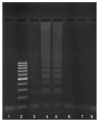Evaluation and Optimization of Loop-Mediated Isothermal Amplification (LAMP) Technique for Capripoxvirus Diagnosis and Its Comparison with PCR Method
- PMID: 40599456
- PMCID: PMC12207928
- DOI: 10.32592/ARI.2024.79.6.1183
Evaluation and Optimization of Loop-Mediated Isothermal Amplification (LAMP) Technique for Capripoxvirus Diagnosis and Its Comparison with PCR Method
Abstract
Sheep pox (SP), goat pox (GP), and lumpy skin disease (LSD) are caused by subspecies of the capripox virus (CaPVs). They are significant pathogens of sheep, goats, and cattle. The causative agent is the capripox virus (CaPV), which was first isolated in South Africa. The viruses responsible for sheep pox (SP), goat pox (GP), and lumpy skin disease (LSD) are morphologically indistinguishable and have been adapted to different host species (4). Serologically, distinguishing between these viruses is challenging, and cross-immunity exists among them (2). The present study reports the evaluation and optimization of a novel loop-mediated isothermal amplification (LAMP) technique for the rapid detection of capripox viruses (CaPVs) and compares it with the polymerase chain reaction (PCR) method. LAMP primers were selected from the P32-protected gene of CaPV. The Safe-Red fluorescent dye was used to monitor the color change from red to bright yellow at a wavelength of 320 nm in positive cases, and the final results were documented through electrophoresis. The proposed LAMP test for the capripox virus demonstrated high specificity and did not cross react with other viruses in the Poxviridae family that present similar clinical symptoms. The optimized LAMP test was then compared with the PCR. The diagnostic sensitivity of LAMP and PCR was found to be identical (100%). The specificity of the LAMP test was evaluated using 30 samples of cow skin that were suspected of lumpy skin disease, along with16 additional samples, including nine positive references, fivenegative references, and two negative controls. A negative reference sample was used to assess the diagnostic sensitivity of LSDV. The proposed LAMP test is simple to implement, cost-effective, and highly sensitive, making it particularly well-suited for the detection of the capripox virus in less developed regions, laboratories, and facilities with limited resources.
Keywords: Capripoxvirus; LAMP; LSDV; PCR.
Conflict of interest statement
The authors certify that they have no conflicts of interest.
Figures




Similar articles
-
Development of a loop-mediated isothermal amplification assay for rapid detection of capripoxviruses.J Clin Microbiol. 2012 May;50(5):1613-20. doi: 10.1128/JCM.06796-11. Epub 2012 Feb 22. J Clin Microbiol. 2012. PMID: 22357504 Free PMC article.
-
Development of the isothermal recombinase polymerase amplification assays for rapid detection of the genus Capripoxvirus.J Virol Methods. 2023 Oct;320:114788. doi: 10.1016/j.jviromet.2023.114788. Epub 2023 Jul 28. J Virol Methods. 2023. PMID: 37517457
-
Loop-mediated isothermal amplification assay for rapid and sensitive detection of sheep pox and goat pox viruses in clinical samples.Mol Cell Probes. 2016 Jun;30(3):174-7. doi: 10.1016/j.mcp.2016.02.004. Epub 2016 Feb 10. Mol Cell Probes. 2016. PMID: 26872529
-
Signs and symptoms to determine if a patient presenting in primary care or hospital outpatient settings has COVID-19.Cochrane Database Syst Rev. 2022 May 20;5(5):CD013665. doi: 10.1002/14651858.CD013665.pub3. Cochrane Database Syst Rev. 2022. PMID: 35593186 Free PMC article.
-
Rapid, point-of-care antigen tests for diagnosis of SARS-CoV-2 infection.Cochrane Database Syst Rev. 2022 Jul 22;7(7):CD013705. doi: 10.1002/14651858.CD013705.pub3. Cochrane Database Syst Rev. 2022. PMID: 35866452 Free PMC article.
References
-
- Babiuk S, Bowden TR, Boyle DB, Wallace DB, Kitching RP. Capripoxviruses: An Emerging Worldwide Threat to Sheep, Goats and Cattle. Transboundary and Emerging Diseases. 2008; 55(7):263–72. - PubMed
-
- Heine HG, Stevens MP, Foord AJ, Boyle DB. A capripoxvirus detection PCR and antibody ELISA based on the major antigen P32, the homolog of the vaccinia virus H3L gene. Journal of Immunological Methods. 1999;227(1-2):187–96. - PubMed
Publication types
MeSH terms
Supplementary concepts
LinkOut - more resources
Full Text Sources
Research Materials
